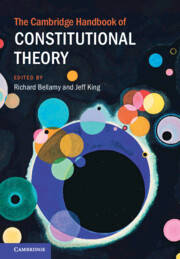Book contents
- The Cambridge Handbook of Constitutional Theory
- The Cambridge Handbook of Constitutional Theory
- Copyright page
- Contents
- Figures
- Contributors
- Frontispiece
- Preface and Acknowledgements
- 1 Introduction
- Part I Values
- Part II Modalities
- 10 Impartiality
- 11 Constitutional Legitimacy
- 12 Sovereignty
- 13 Constituent Power
- 14 Representation
- 15 Deliberation
- 16 Opposition
- 17 The Separation of Powers
- 18 The Rule of Law
- 19 Constitutional Conventions
- 20 Secularism
- 21 Constitutional Review
- 22 Constitutional Interpretation
- 23 Proportionality
- 24 Civil Disobedience
- 25 Constitutional Entrenchment
- 26 Emergency Powers
- 27 Regulation
- 28 Cost–Benefit Analysis
- 29 Revolution
- Part III Institutions
- Part IV Challenges for Constitutional Democracy
- Bibliography
- Index
- References
25 - Constitutional Entrenchment
from Part II - Modalities
Published online by Cambridge University Press: 27 March 2025
- The Cambridge Handbook of Constitutional Theory
- The Cambridge Handbook of Constitutional Theory
- Copyright page
- Contents
- Figures
- Contributors
- Frontispiece
- Preface and Acknowledgements
- 1 Introduction
- Part I Values
- Part II Modalities
- 10 Impartiality
- 11 Constitutional Legitimacy
- 12 Sovereignty
- 13 Constituent Power
- 14 Representation
- 15 Deliberation
- 16 Opposition
- 17 The Separation of Powers
- 18 The Rule of Law
- 19 Constitutional Conventions
- 20 Secularism
- 21 Constitutional Review
- 22 Constitutional Interpretation
- 23 Proportionality
- 24 Civil Disobedience
- 25 Constitutional Entrenchment
- 26 Emergency Powers
- 27 Regulation
- 28 Cost–Benefit Analysis
- 29 Revolution
- Part III Institutions
- Part IV Challenges for Constitutional Democracy
- Bibliography
- Index
- References
Summary
Entrenchment is a constitutional tool that renders legal change more difficult. This chapter examines the forms entrenchment can take, and the reasons for and against entrenchment. It argues that entrenchment can, on occasion, help resolve constitutional problems by requiring law-making institutions to depart from the normal way in which they effect legal change. Entrenchment rules are at their most attractive where there is a connection between the reason for entrenchment – the reason why the normal rules of legal change are problematic in a particular area of law – the type of entrenchment rule adopted, and the area of law entrenched.
Keywords
- Type
- Chapter
- Information
- The Cambridge Handbook of Constitutional Theory , pp. 417 - 432Publisher: Cambridge University PressPrint publication year: 2025

